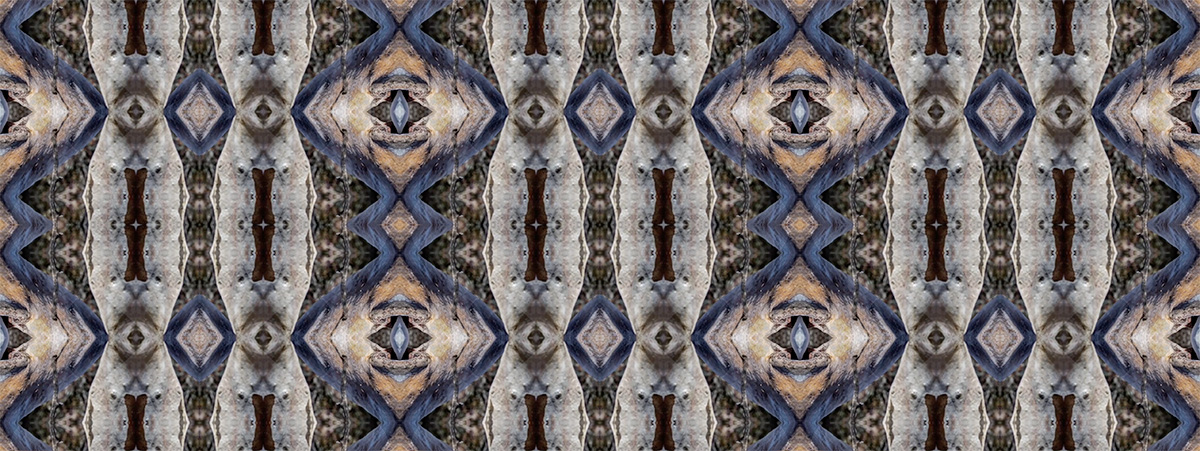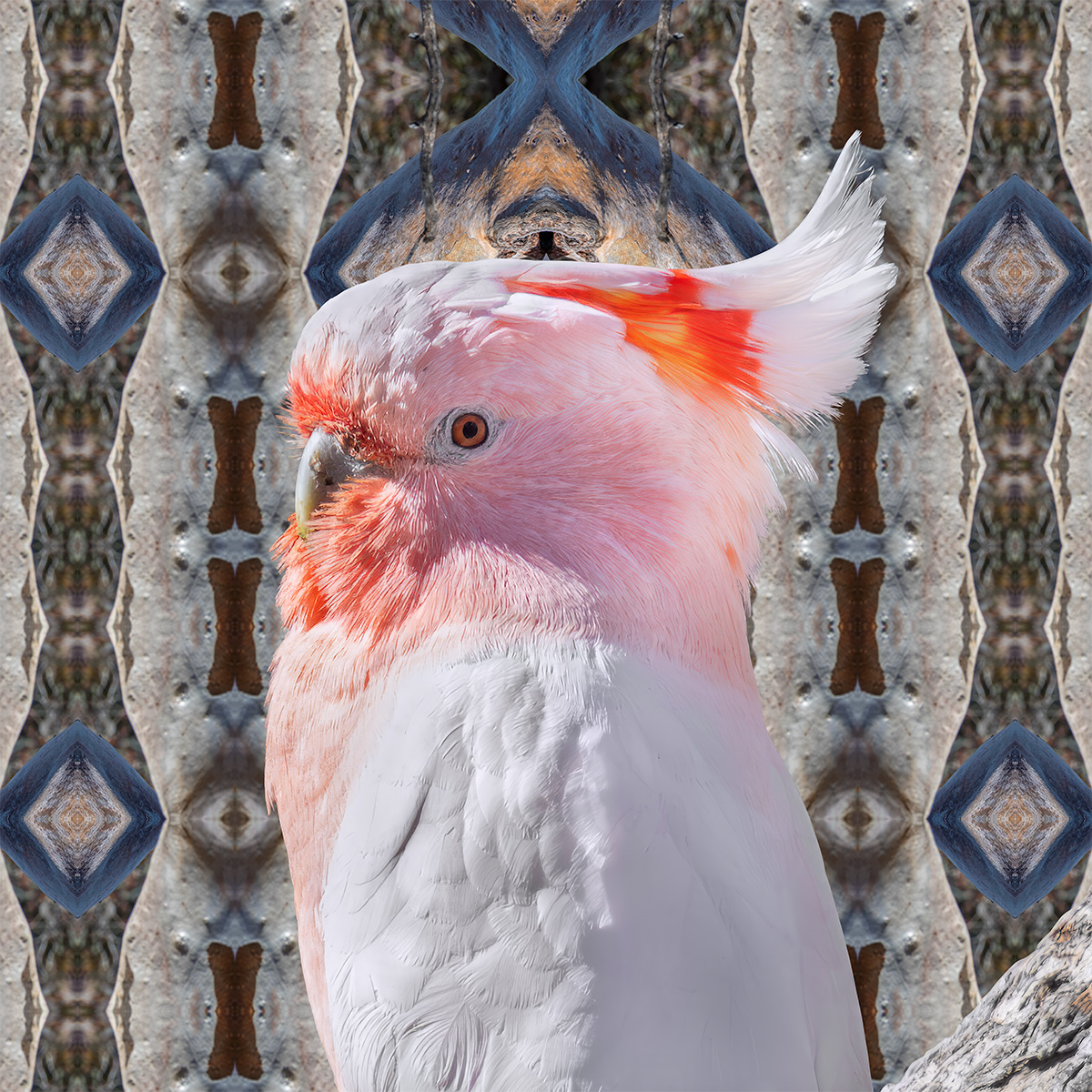
CATALOGUE ESSAY: KARTA KARTAKA (PINK COCKATOO)
There is a bird with plumage dusted white and pink that nests in tree hollows, its presence lets you know the tree is very old. In Kent Morris’s photographic series karta kartaka (pink cockatoo), this bird announces itself from a cavern in a river red gum that stands in Mutawintji National Park. When this bird raises its crest, it will flash feathers striped yellow and red, making patterns that resemble the first rays of glowing sunlight, bursting through the sky and across the land at sunrise. Soon it will take and make its call.
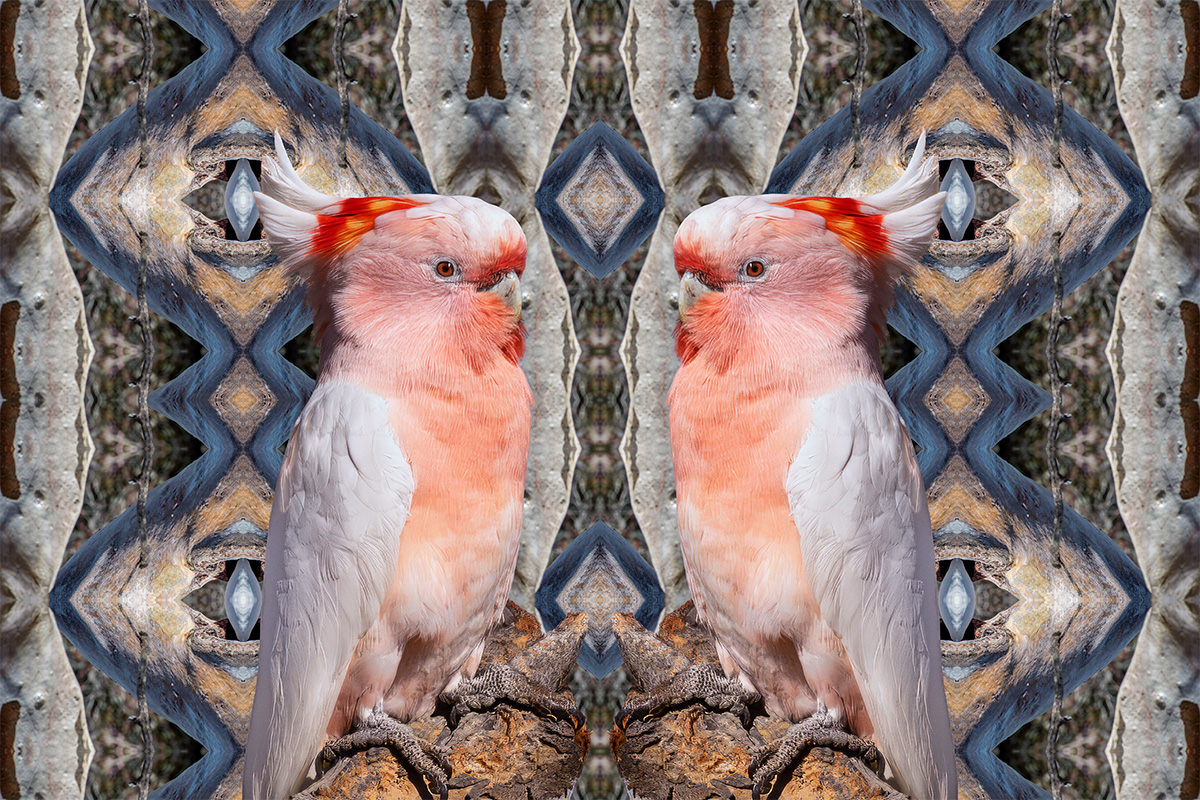
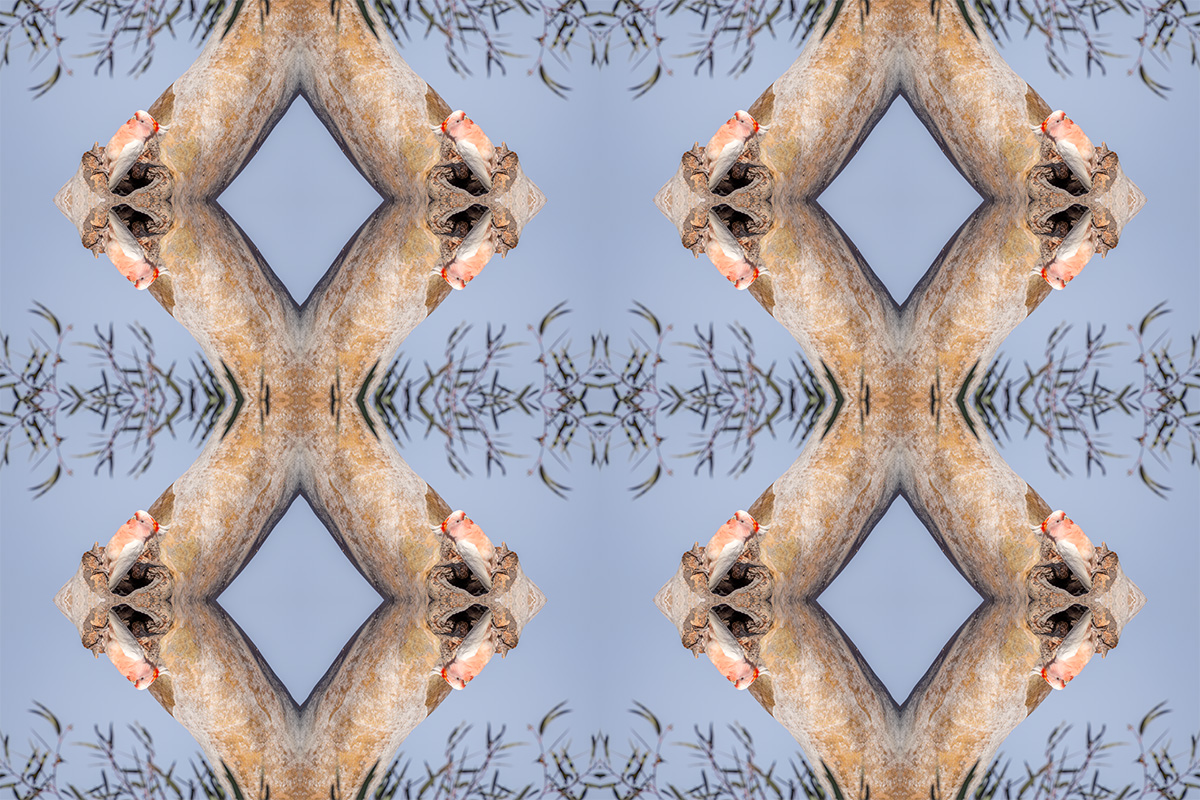
It’s named karta kartaka by Barkindji peoples, which phonetically echoes the bird’s own strident call, as if recognising it as a creative and communicative being that sings out its name. In this sense, Morris’s photographic series attends to karta kartaka, as devotional reiteration of Indigenous sovereign presence, centring the bird against geometric patterns, which draw the eye and so the viewer into the kaleidoscopic depth of an eternal-present grounded but not enclosed in Mutawintji.1 These photographs tell stories of the pink cockatoo’s belonging in the ancestral order, along with the layered history of colonial violence and ecological devastation, and millennia of art, culture, and language engrained in Country at Mutawintji.
Naming is a powerful practice and when carried out in the service of colonialism is often a violent operation. The (re)naming and classification of all worldly flora and fauna has gone “hand in hand with various forms of colonial expansion and enterprise.”2 karta kartaka has multiple names across different Indigenous language groups but since colonisation has been given a succession of labels: cacatua leadbeateri, Leadbeater’s cockatoo, Major Mitchell’s cockatoo, pink cockatoo.
These monikers coincide with Indigenous expropriation, distorting Indigenous land relations and claiming nature as property of the British or the settler nation. ‘Leadbeater’ or ’leadbeateri’ captures the bird for British natural history in commemoration of the London naturalist and taxidermist, Benjamin Leadbeater (1773–1851). Leadbeater signifies an acquisition of British colonialism and erases the bird’s Indigenous names, which is to say it eviscerates the Indigenous paradigm that the bird – a relational being – exists within.
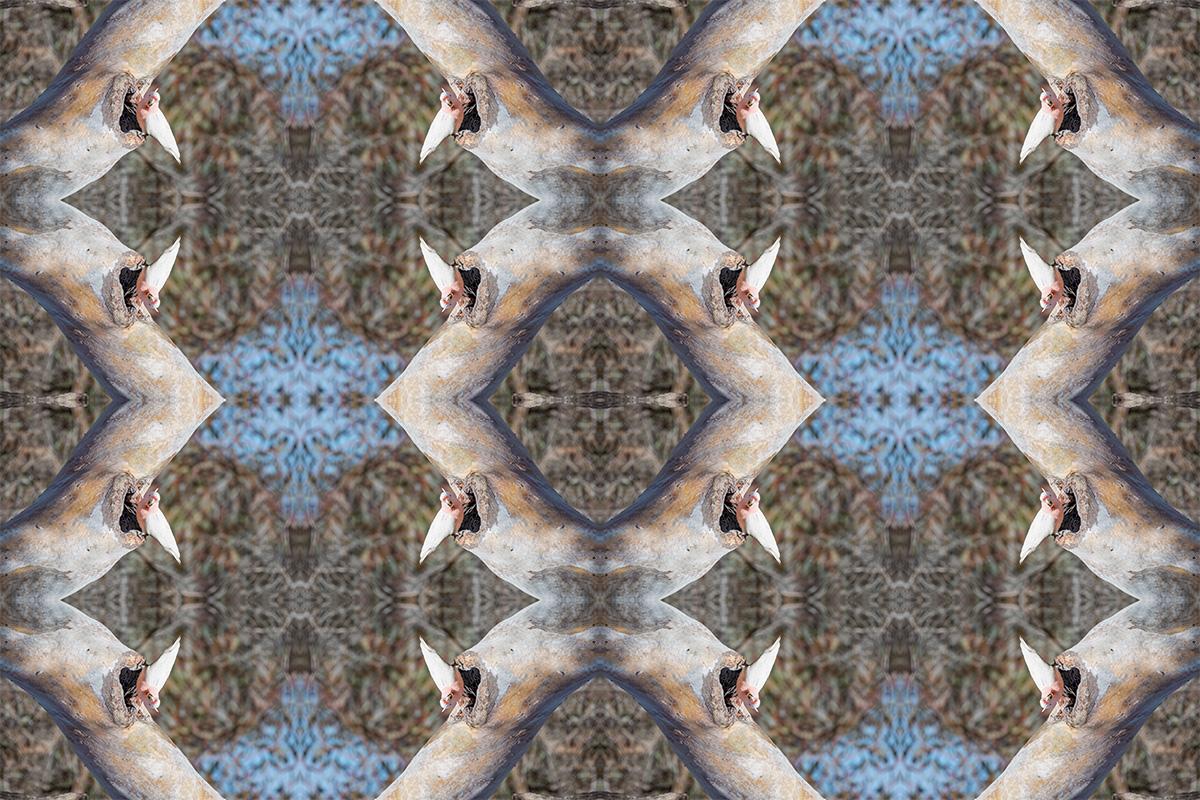
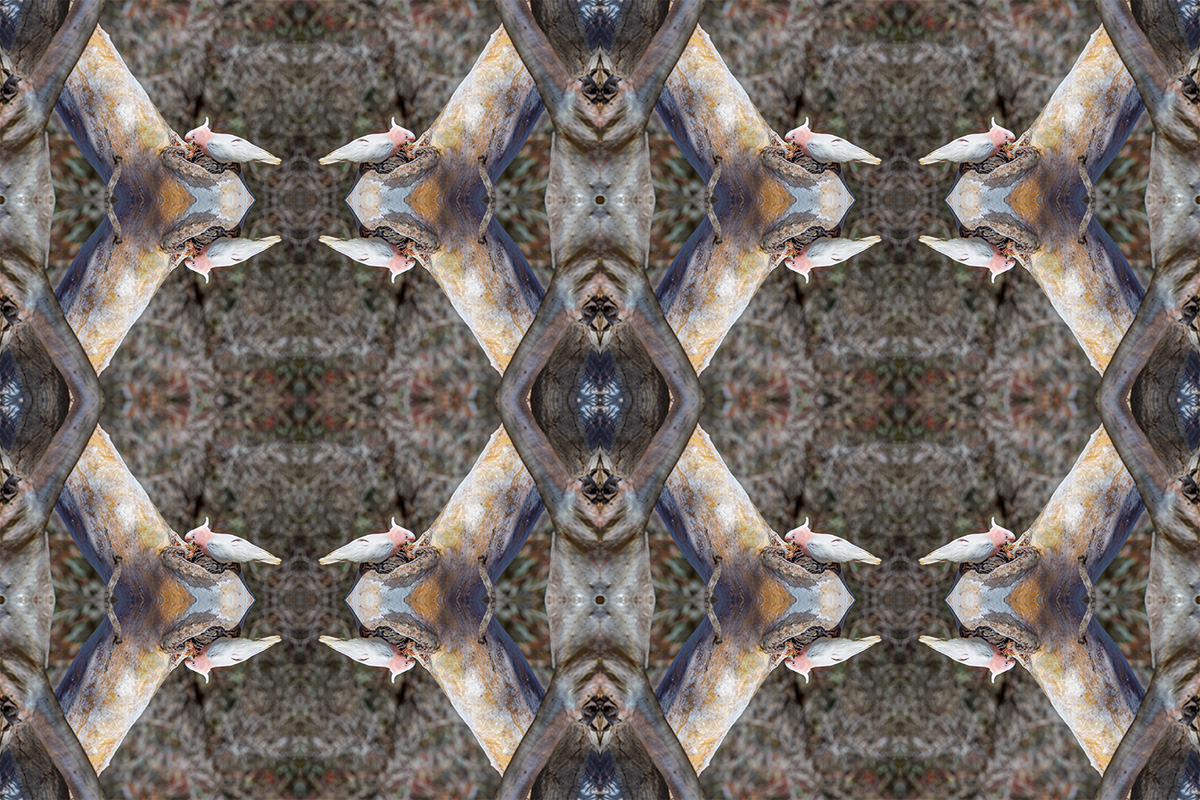
In the construction of the Australian nation-state, naming is a mechanism of what Aileen Moreton-Robinson (Goenpul) identifies as the “patriarchal white possessive logic” that operates “within discourse to circulate sets of meanings about ownership of the nation, as part of commonsense knowledge, decision making, and socially produced conventions.” 3 Leadbeater or Major Mitchell’s cockatoo enclose the bird in a filial relationship – the creature and nature (ancestral beings and Country) are given a false origin in white male ‘discovery.’ Here naming is an exclusionary double manoeuvre, whereby Indigenous dispossession is a by-product of white possession.
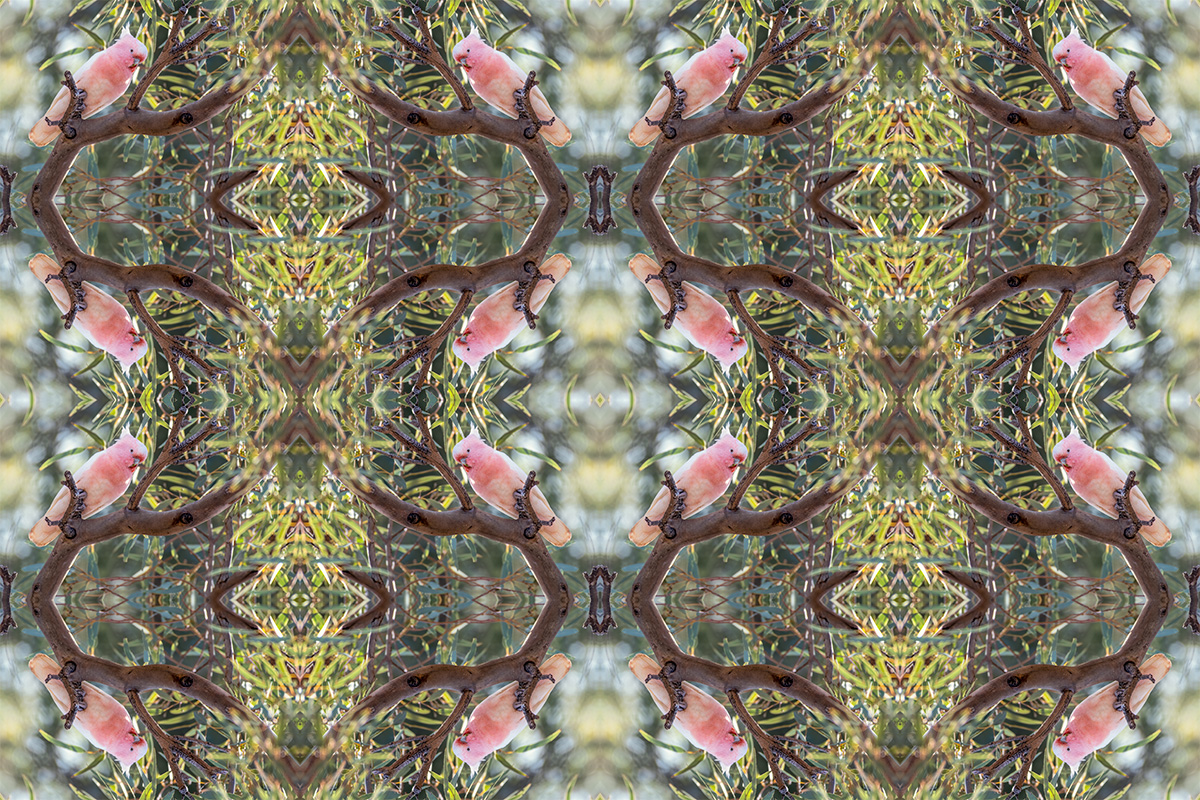
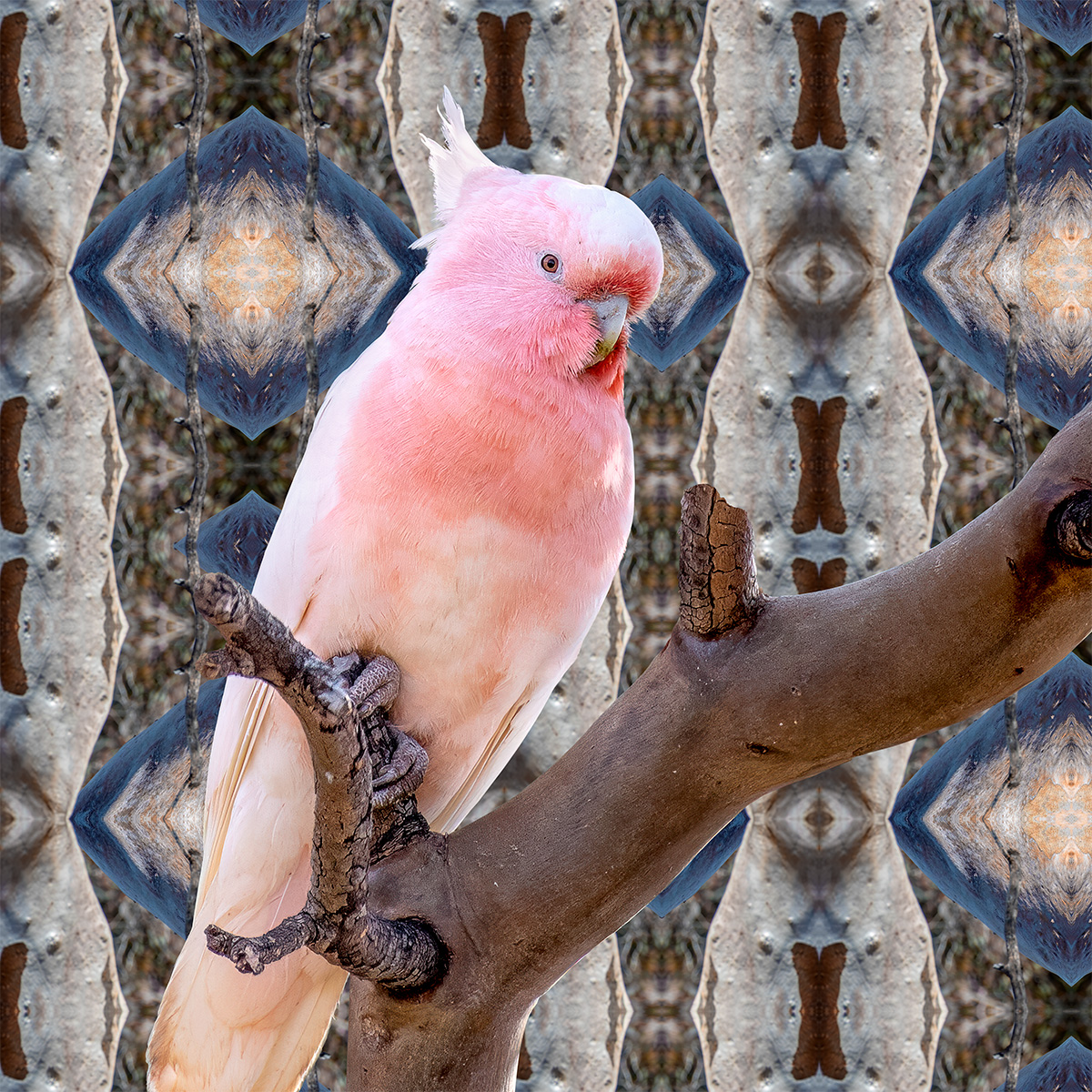
Whereas karta kartaka names the bird as a being with a significant part in Barkindji cosmology. Embedded in the term, which is narrative and ecological, is the ancestral significance of the bird. It doesn’t simply name a creature in the world but a way of life, a story of how the world came to be, in which the bird dwells in the hollow of a tree. Senior storyteller Alf Barlow (c.1888–1961) recounts, the “cocky in a hollow tree” as a place naming maker, part of the Two Ngatyi (Rainbow Serpents) Travelling creation story.4 This is entwined in Morris’s photographs of karta kartaka resting in gum trees. For thousands of years (Mutawintji, where Morris took the photographs, has been an Aboriginal gathering place for at least 8OOO years) the bird existed alongside many Indigenous peoples but in just over 25O years since colonial invasion it has become endangered.

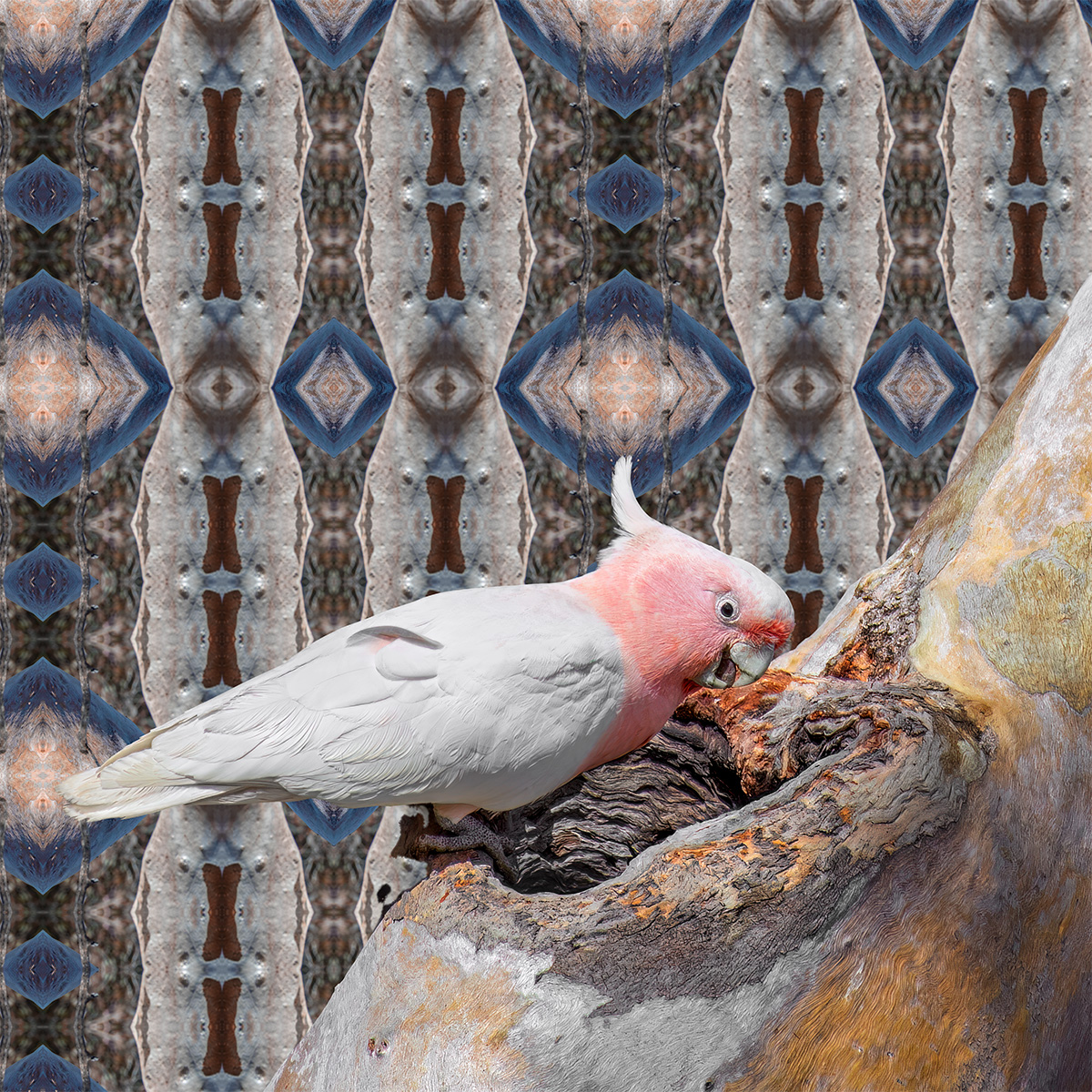
The designation Major Mitchell’s cockatoo re-enacts colonial rupture. Not simply is this name an artefact of the history of Indigenous dispossession, it is a grim reminder of frontier massacre, trauma, and the ongoing threat of extinction. In 1836, Mitchell led a massacre of at least seven Barkindji people at Mt Dispersion, near the Murray River in New South Wales.5 At the time of the Mt Dispersion massacre, Mitchell was the surveyor general for NSW and in awe of the bird, which he erroneously thought of as distinct and separable from its environment: “Few birds more enliven the monotonous hues of the Australian forest than this beautiful species whose pink-coloured wings and flowing crest might have embellished the air of a more voluptuous region.”6
Mitchell’s view of the cockatoo is in stark contrast to complex ecological Indigenous understanding of the creature. Although he had a nescient fascination with the bird, he likely played a larger role in the species’ demise than its survival, due to his work as a surveyor and role in the massacre. The clearing of the bird’s habitat for building materials and pastoralism played a role in depleting the cockatoo’s population.7 And he was directly involved in killing and the dispossession of the Barkindji who have been deeply invested in maintaining reciprocal relations with the bird for millennia.
While the horror of Mitchell’s actions played out in the first half of the 18OOs, it wasn’t until 1977 that the cockatoo was renamed in his honour, by the Royal Australian Ornithologists Union (now BirdLife Australia). With 141 years to reflect on the mass killing of Barkindji at Mt Dispersion, Mitchell’s violence against Indigenous people and his role in harming the environment, ignorance is not adequate to explain the decision to rename the bird after a massacrist.
The 1977 decision to claim the bird as Major Mitchell’s cockatoo is an example of settler-Australian culture’s filial duty to patriarchal settler-colonialism. Not simply an act of paying homage to a frontier settler and mass killer (treating as socially acceptable Aboriginal massacres), with a disregard for the hurt and grief this might bring Barkindji and Indigenous people more broadly but reinscribing the double erasure of Indigenous people and our knowledge.
As a corrective to the egregious name, BirdLife Australia, the organisation that continues to take responsibility for officiating colonial taxonomy in this country, now calls the bird the pink cockatoo. The new appellation does not recall the violence uttered in Major Mitchell’s name. At a glance, it is seemingly benign – a descriptive name – but it remains corrosive to Indigenous stories of the bird, removing the ancestral significance and ecological entanglement that a name like karta kartaka connotes.
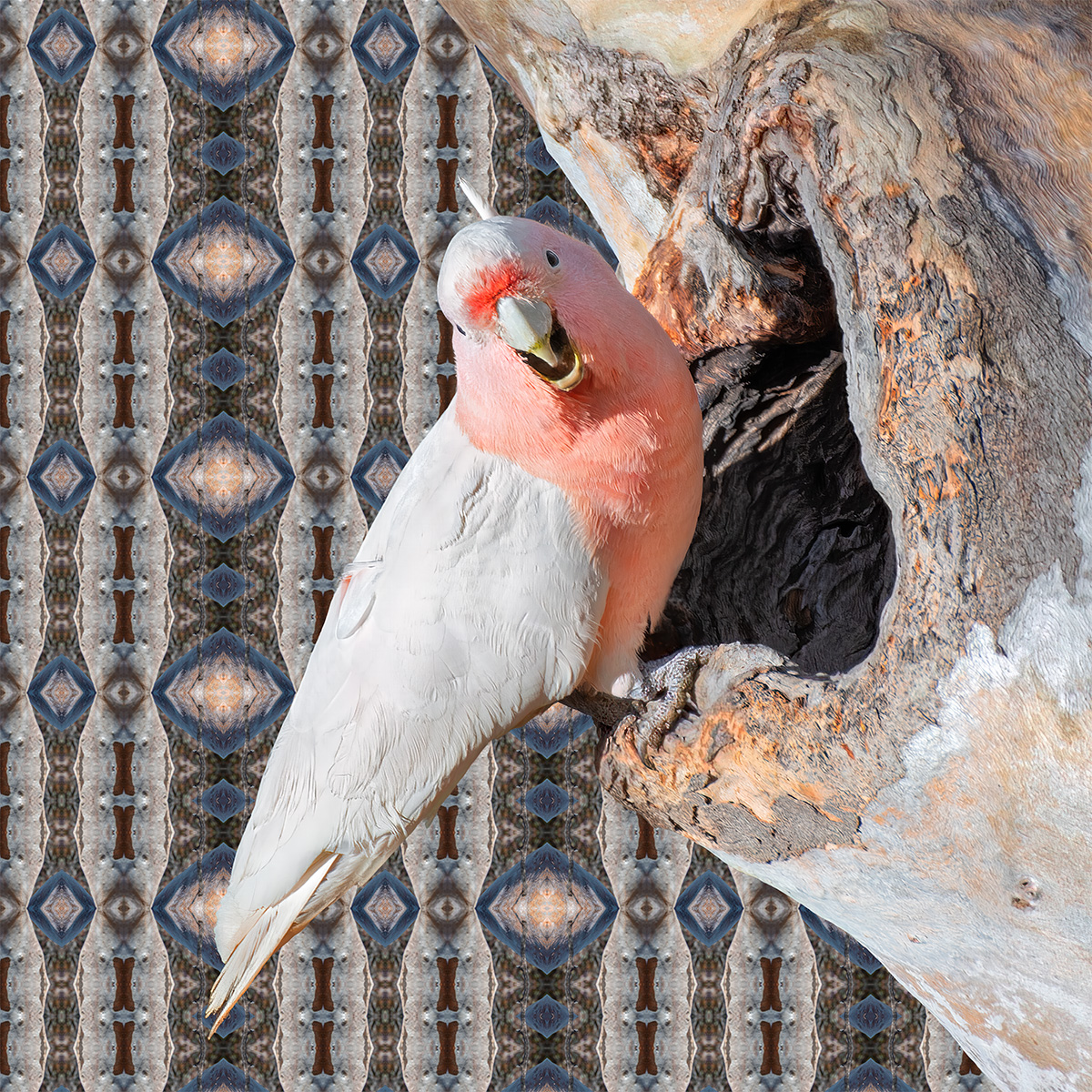
Morris’s parenthetic uses of pink cockatoo in the title of his series strategically invites the viewer to consider the relationship between naming and worldview. His photographs are a reminder of this history but importantly, they offer a way forward. The works show a beautiful bird against a background that almost shimmers engaging aesthetic desire, which draws the viewer into an entangled history, which couldn’t be further from Mitchell’s detached observations of the bird. He demonstrates visuality is political – a socially and historically situated act – a way of seeing the world, of being in the world that can deny or reciprocate the birds’ call “karta kartaka.”
The poetics and politics of Indigenous naming practices tell stories of relational belonging, deep, enduring love for Country – its beings, spirit, land – and a dialogical understanding of history. In a period, which is speculated to be the ‘sixth mass extinction’, a world prefigured or re-animated by Indigenous names that carry ecological specificity and
historical depth might be the only way to ensure the survival of birds like this one.
8 Whether in whispers or held on the tongues of those who knew, Indigenous names like karta kartaka have survived and now hold open the possibility for us to attend to ecology, cosmology, and history’s multiple truths even when they are painful to endure.
TRISTEN HARWOOD
1 This term is drawn from Stephen Gilchrist’s exhibition Everywhen: The Eternal Present in Indigenous Art from Australia (2O16 –2O17) and John Mawurndjul’s survey exhibition, John Mawurndjul: I am the old and the new (2O19–2O2O). The ‘eternal’ here is ongoing and open-ended rather than fixed and static. It is remade, reinterpreted, repaired, and so forth, hence “devotional reiteration.”
2 Jack Halberstam, Trans*: A Quick and Quirky Account of Gender Variability (California: University of California Press, 2O18), 5.
3 Aileen Moreton-Robinson, The White Possessive: property, power, and Indigenous
Sovereignty (Minneapolis: University of Minnesota Press 2O15), xii.
4 Alf Barlow quoted in Jeremy Beckett and Luise Hercus, The Two Rainbow Serpents Travelling: Mura track narratives from the ‘Corner Country’ (Canberra: ANU E Press, 2OO9), 3O.
5 ‘E.Examination of Jemmy Piper, an aboriginal native before the Executive Council, December 16, 1836’, The Colonist. New South Wales, Australia. 2 February 1837, 8, accessed 14 January 2O24, via Trove.
6 D. W. A. Baker, ‘Sir Thomas Livingstone Mitchell (1792–1855)’, Australian Dictionary of Biography, Volume 2, 1967, published online 2OO6, accessed 14 January 2O24.
7 Bron Willis, ‘Major Mitchell’s cockatoos in terminal decline in Victoria,’ Australian Geographic, 9 March 2O18, accessed 14 January 2O24.
8 Numerous scholars in extinction studies and the environmental humanities have used variations of the term ‘sixth mass extinction’ to describe the threat of extinction that many species are currently facing. I was most recently reminded of the term while reading Thom van Doreen, ‘Encountering crows: Living with wildlife in a changing world’, 8 December 2O14, accessed on 14 January 2O24 via thomvandooren.org
